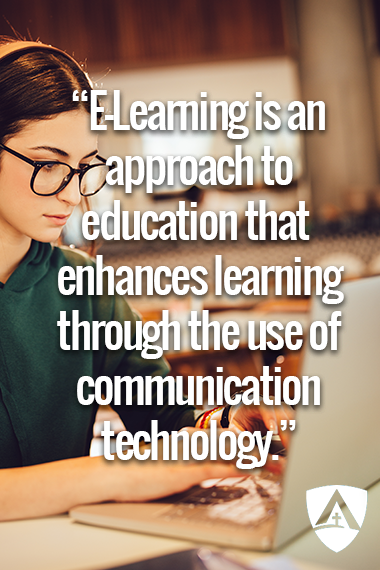E-learning reflects the reality of how people learn in the 21st century. As more and more parents are choosing e-learning for their children, there is a need to respond to the following questions: (1) What is e-learning? (2) What are the benefits of e-learning? (3) What are the challenges of e-learning? (4) How does my child apply his/her personal strengths to e-learning? (5) What is the future of e-learning?

What is e-learning?
E-learning is an approach to education that enhances learning through the use of communication technology. E-learning can be instructor-led, computer-based, or a combination of the two. It provides greater convenience for parents who wish to homeschool their elementary students. It is a safety net for middle school students when their emotions are unpredictable, which might lead to insecurity and bullying in brick-and-mortar schools. For high school students, e-learning provides flexibility and self-paced learning, while avoiding travel time. In e-learning, the teacher’s role is changed from traditional “a sage on the stage” to an online learning “guide on the side.”1 Students are active participants in e-learning and accountable for their own learning experiences.
What are the benefits of e-learning?
E-learning is primarily designed around the learner and allows for self-paced learning, providing students with opportunities to speed up or slow down as necessary. The flexibility offered by online technologies can help support the needs of diverse learners. High achieving students can work ahead and finish the school year earlier, which provides time to travel or begin the next school year ahead of the class. On the other hand, students that need more time for mastering skills may be able to extend their school year to include summer school. And for students with learning disabilities, the online curriculum can be modified. Importantly, e-learners benefit from personalized learning, individualized instruction, group lessons via web-conferencing programs, and a safe home environment.
What are the challenges of e-learning?
Since e-learning is different from the traditional form of education where learners get to see others within the same physical space, parents need to be creative for their child’s social development and involve him/her in sports, fine arts , or other activities within their community or church settings. Next, teacher availability can vary, with response times ranging from one hour, a few hours, or twenty-four hours. This is why it is important for parents to evaluate what option is the best for their child with their counselor’s guidance. In e-learning, teachers are providing various online sources that students can access and interact with. However, it is a student’s responsibility to log in, take the time to learn the tips, and then apply them to assignments. E-learning requires student motivation and parental support, especially for younger children.
How does my child apply his/her personal strengths to e-learning?
The authentic use of technology transforms teacher’s roles, learner’s roles, the conceptualization of knowledge, the process of teaching and learning, and assessment.2 As parents assist their children at home, it is important to observe the ways their children retain information. Some children learn best by reading, some when they see visual presentations, some when they summarize learned information in a notebook, and for some, it is a combination of reading, visuals, and note-taking. Also, for younger children, morning time is the best for working on assignments. For middle school students, their online school might start at nine or even ten in the morning. For high school students, late afternoon might work the best, especially if they work part-time in the morning. In regards to their personalized time of school work, students need to spend four to six hours daily on their assignments for mastery learning.
What is the future of e-learning?
Increased access to the Internet and greater bandwidth are both expected to increase the number of students moving into online learning.3 By utilizing emerging technology to individualize experiences, students are provided increasingly personalized instruction, making education less one-size-fits-all.
References
1 Keengwe, G., Onchwari, G., & Agamba, J. (2014). Promoting effective e-learning practices through the constructivist pedagogy. Educ Inf Technol., 19:887-898.
2 Reil, M., & Becker, H. (2000). The beliefs, practices, and computer use of teacher leaders. New Orleans: AERA presentation. Retrieved from http://www.crito.uci.edu/tlc/findings/area/.
3 Curtis, H. & Werth, L. (2015). Fostering student success and engagement in a K-12 online school. Journal of Online Learning Research, 1(2), 163-190.
If you are looking for a curriculum that allows students to work from home with their families, then consider Enlightium Academy (Enlightium). Enlightium is a fully accredited online private Christian school that allows students to work at their own pace with a flexible schedule. Our affordable tuition, individualized curriculum, and simple admissions process maintain the advantages of a homeschool education while also preparing students well for college. Additionally, Enlightium offers record-keeping and has worked with families in all 50 states to meet state requirements. Feel free to call us at 866-488-4818 if you have any questions about transferring to Enlightium Academy.
